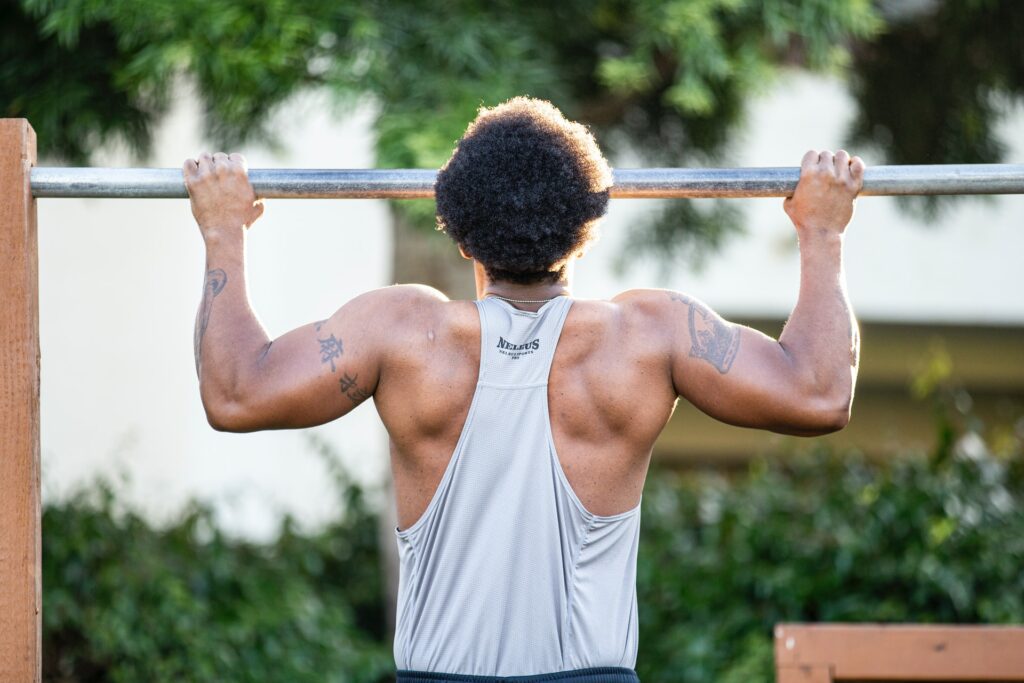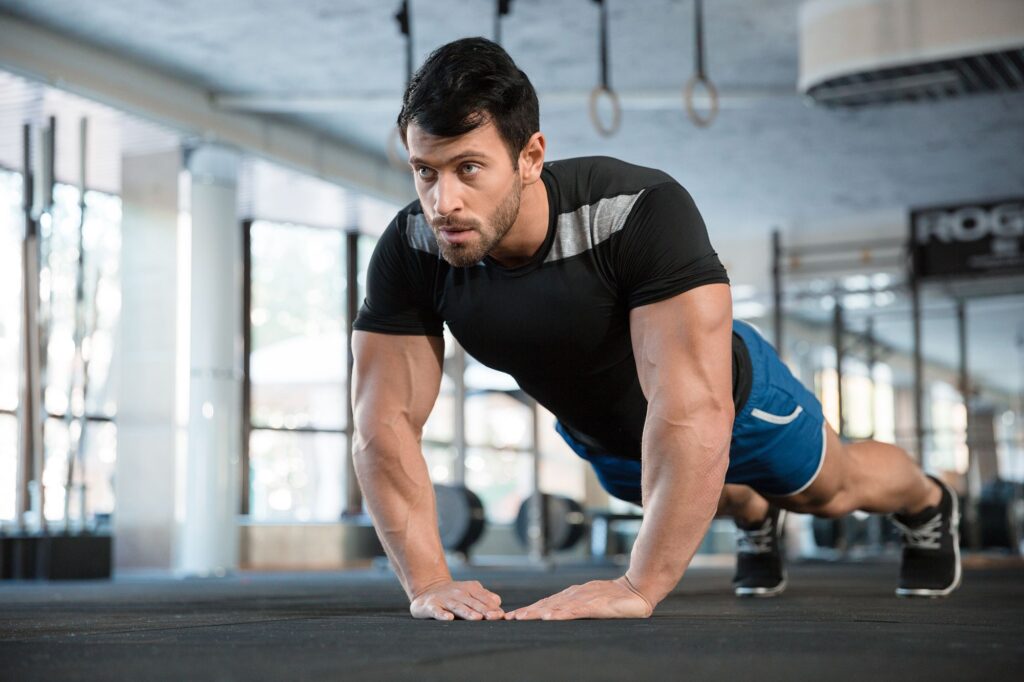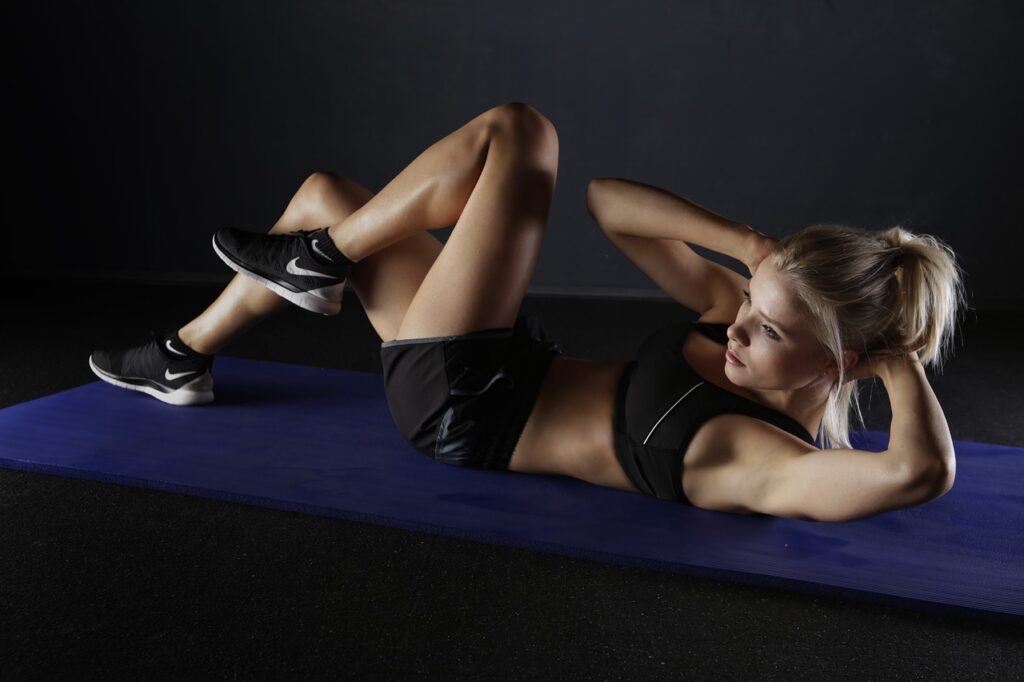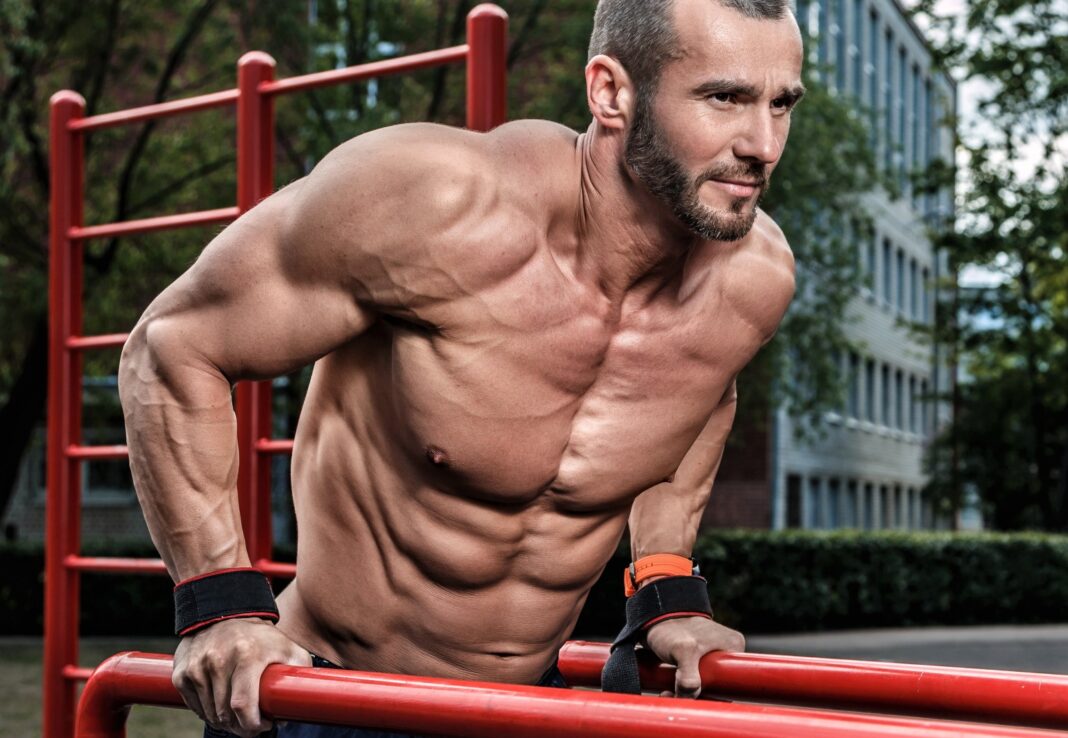No weighting. You are the resistance. Whether you weigh 150 or 300, you’re hauling those pounds around every day. What you’re probably not doing is using your body’s weight for a workout. However, you could, and maybe you should. With a minimum amount of stationary equipment—chinning bar, dipping bars—or no equipment at all, you can train your entire physique.
But if you’re a member of a gym chock-full of dumbbells and barbells and all manner of machines, why would you want to train without all those tools? Maybe you’re traveling, stuck in a hotel room or campsite. Maybe you’re too busy to get to the gym for a few days. Or maybe you just want to try something different to free yourself from the rut of those same old, metallic moves. And you don’t have to do a full-body workout sans weights. There are likely several bodyweight exercises that you can incorporate into your current routine. Let’s explore the best of them.
CHEST: BODYWEIGHT EXERCISES
It’s easy to train chest without weights with a couple of very basic exercises.
DIP
Dips focus on your lower chest, as well as your front delts and triceps. Lean into each rep to work your pecs more and triceps less. A chain over your shoulders or weight attached to a belt adds resistance. Think of that as bodyweight plus weight.
PUSH-UP
If done in the standard style, push-ups are the equivalent of upside-down, light bench presses. But there are several variations. With your legs elevated (feet on a bench, hands on the floor), push-ups focus more on the upper pecs, and they’re harder. Conversely, with your torso elevated (hands on a bench, feet on the floor), the tension is greater on the lower pecs, and they’re easier. You can also use push-up handles to expand the range of motion.
BACK: BODYWEIGHT EXERCISES
Like chest, back is another easy body part to hit without weights, though to some degree that depends on how strong you are in the pull-up.
PULL-UP
Pull-ups can be done with a variety of grips (wide, moderate, close, overhand, underhand), each of which works your back in a slightly different way. If you can’t get eight reps on your own, use a band under your legs or the helping hands of a spotter to remove some stress. If you can get more than 15 reps on your own, use a chain or helping hands to add resistance.

INVERTED ROW
The other key bodyweight back exercise is the INVERTED ROW. This is essentially a pullup with your heels on the floor and body held flat. Set a Smith machine bar or a barbell in a power rack at slightly higher than arms-length when you’re lying on the floor, and pull yourself up as if rowing upside-down.
SHOULDERS: BODYWEIGHT EXERCISES
HANDSTAND PUSH-UP
You can approximate a shoulder press with your own body providing the weight. The handstand push-up is done next to a wall, facing away, with your heels against the wall. Press yourself up and down. Your head will limit your range of motion.
PUSHBACK PUSH-UP
If you’re not strong enough to knock out 10 handstand push-ups, do the pushback push-up. Each rep starts and ends as if in the bottom position of a traditional push-up, but you push yourself back and up, straightening your arms out in front of you and bending your knees. So, at the top you’re in a crawl position. Pushbacks have the advantage of a longer range of motion than handstands. Each of these will target your front delts and your core.
WIDE-GRIP INVERTED ROW
Rear delts will get some work with regular pull-ups and inverted rows. But if you want to focus more on rear delts, include wide-grip inverted rows in your bodyweight shoulder routine.
ISOMETRIC HOLD
Medial delts can be worked with isometric holds. Hold your arms perfectly straight and parallel to the floor for as long as possible. Add resistance by having someone press down on your arms while you keep them parallel, or (cheating on our “bodyweight” definition) hold the sort of light items you can find almost anywhere: drinking glasses, unopened soda cans, books, etc.
BICEPS: BODYWEIGHT EXERCISES
CHIN-UP
Chin-ups are underhand pull-ups, and they work your biceps more and back less than overhand pull-ups.
UNDERHAND INVERTED ROW
Likewise, underhand inverted rows work your biceps more and back less than overhand inverted rows.
TRICEPS: BODYWEIGHT EXERCISES
BENCH DIP
Bench dips, done with your hands slightly behind you and your legs straight out in front of you, target your triceps, especially the lateral and medial heads. You can do these with two benches or chairs: one for your hands, the other for your feet.
UPRIGHT DIP
If you do dips with your torso upright (don’t lean forward), they focus more on your triceps and less on your chest.
NARROW PUSH-UP
Do push-ups with a narrow grip (thumbs within six inches of each other) to focus less on your chest and more on your triceps. These are often called diamond push-ups when the thumbs and forefingers touch to form a sort of diamond.

QUADRICEPS: BODYWEIGHT EXERCISES
Bodyweight quad exercises are typically high-rep variations of the squat.
BULGARIAN SPLIT SQUAT
This is a one-leg squat. The non-working leg is bent with that foot behind you and against a bench or chair. If this is “too easy” with just your bodyweight, crank up the intensity with high reps and/or slow, isometric reps.
FULL, BODYWEIGHT SQUAT
Speaking of “too easy.” This is the traditional deep knee bend, and at first blush you might be thinking of gym class calisthenics. Don’t. To make it harder, go through a full range of motion and go high rep. And we mean full, and we mean high rep. Go glutes-to-ankles on every rep, and just keep cranking out reps. You should be able to hit at least 30 reps. When you can get 200 reps or more, you won’t need a second set.
WALL SQUAT
Isometric wall squats are another leg endurance test. Crouch with your thighs parallel to the floor and your back flat against the wall, as if sitting in an invisible chair. Stay in that position as long as you can. Wall squats are a great way to finish off a bodyweight leg workout, or you can do them immediately after another bodyweight leg lift, like lunges or Bulgarian split squats, to thoroughly toast your wheels without weights.
HAMSTRINGS/GLUTES: BODYWEIGHT EXERCISES
LUNGE
Lunges work your entire lower body, but a study showed they target the hamstrings and glutes more than the quads. You can get a good workout doing walking lunges with just your bodyweight if you go far enough and take deep strides. The trailing knee should touch or nearly touch the floor on each rep.
STAIR RUNNING
Stair running is a bodyweight cardio exercise that does a great job of targeting the glutes.
CALVES: BODYWEIGHT EXERCISES
Without weights, you need to make the standing calf raise harder. Note the superb calves of many ballerinas who spend a lot of time on their tiptoes.
ISOMETRIC HOLD CALF RAISE
Go shoeless on a flat floor, and don’t hold anything to steady yourself. Then rise up very slowly, squeeze hard, and hold each contraction. Lower yourself at normal speed. It can be difficult to balance yourself, but, once you get the hang of it, this is a unique way of targeting calves.
ONE-LEG CALF RAISE
Raise and lower yourself with only one calf at a time, being sure to get a maximum stretch and contraction on each rep. You can do these on a staircase riser or block. Alternate legs or do all the reps for one calf and then the other.
ABDOMINALS: BODYWEIGHT EXERCISES
Some of the best best ab exercises are done with only your bodyweight. In fact, as we explored in this article, the vertical leg raise, incline curl-up, and bicycle crunch are three of the four best ab exercises, according to scientific studies, and all use only your own body as resistance.
VERTICAL LEG RAISE
These can be done hanging with arm straps or in a captain’s chair with your forearms balanced on pads. The important thing is to raise your knees as high as possible so that your butt comes up and your spine curls forward. Doing it in this way, without swinging, maximally activates your abs. (It’s also contrary to much “expert advice,” which incorrectly tells you to keep your torso rigidly horizontal.) The straighter (and longer) your legs are, the greater the resistance. Keep your legs bent until you’re strong enough to use straight legs. You can also start with straight legs and bend them as you fatigue.
INCLINE CURL-UP
Lie face-up on a decline bench with your head near the top. Grip the support or pads behind your head. Start with your knees bent. Raise your legs, butt, and back up while contracting your abs and curling your torso. At the top, your knees should be near or between your elbows, and your thighs should be approximately parallel to the floor. If you get fatigued, shorten the range of motion, turning this into more of a knee raise, but continue focusing on maximal contractions on each rep.
BICYCLE CRUNCH
Lie on the floor with your hands behind or beside your head and legs straight and, if you can, held a few inches off the floor. Raise one knee towards your chest, and simultaneously raise your torso and twist so the opposite elbow comes toward the raised knee. On the next rep, raise the other knee and twist so the other elbow comes towards it. Resist the temptation to go fast. Instead, focus on a maximal abdominal contraction on each rep.

BODYWEIGHT TRAINING BASICS
✔️ Bodyweight workouts can be done almost anywhere, including a hotel room or park.
✔️ The easiest way to use virtually all of your bodyweight as resistance is to pull or push while suspended, as in a pullup or dip.
✔️ Because choices are limited, you may need to focus on a single exercise for eight or more sets.
✔️ Change your hand or foot placement to work different muscles or body part areas.
BODYWEIGHT TRAINING TIPS
✔️ When you can do 15 reps of a bodyweight exercise, increase difficulty by adding resistance, slowing the reps, or reducing rest periods.
✔️ You can also boost intensity by doing supersets or giant sets.
✔️ A training partner can add or reduce resistance. For example, he can hold you down a little or lift you up a little during pullups.
✔️ Bilateral leg exercises, like squats, usually require high reps and maximum ranges of motion.
BODYWEIGHT TRAINING FAQS
Can you build muscle with bodyweight?
Yes. Bodyweight is just another form or resistance, like free weights or the weight stack of a machine, and all resistance training can build muscle.
Is it harder to build muscle with bodyweight exercises?
Not necessarily. It may depend on the body part and whether or not you do only bodyweight exercises. If you do only bodyweight exercises, you may have to do very high reps for body parts like quadriceps (see above), and that may limit your gains. But, for some body parts, like triceps and abdominals, you can get an excellent workout with only bodyweight exercises.
Is bodyweight training good for fat loss?
Yes. Diet is the most important factor for fat loss. But when it comes to cardio, you can get a great workout with calisthenics as well as exercises like stair-climbing.
What happens if I only do bodyweight exercises?
You can get good results in both resistance training and cardio with only bodyweight exercises.
Can you lose weight with only bodyweight exercises?
Yes, but ideally cardio bodyweight exercises should be combined with a low-carb and/or lower calorie diet.
Do bodyweight exercises count as weight training?
Yes. Your body is the weight.
Can you build muscle with bodyweight workouts only?
Yes. But as stated above it may be more easy to thoroughly work some body parts than others.
Can you build muscle with high-rep bodyweight exercises?
Yes. In fact, with many bodyweight exercises, we recommend reps in the 15-25 range or even higher.
Is bodyweight training better than lifting weights?
In regards to results, neither is necessarily better. But it is better in that you can do bodyweight exercises almost anywhere at any time with no actual weight-training equipment.
















































